2014 Peugeot 508 gearbox
[x] Cancel search: gearboxPage 107 of 352
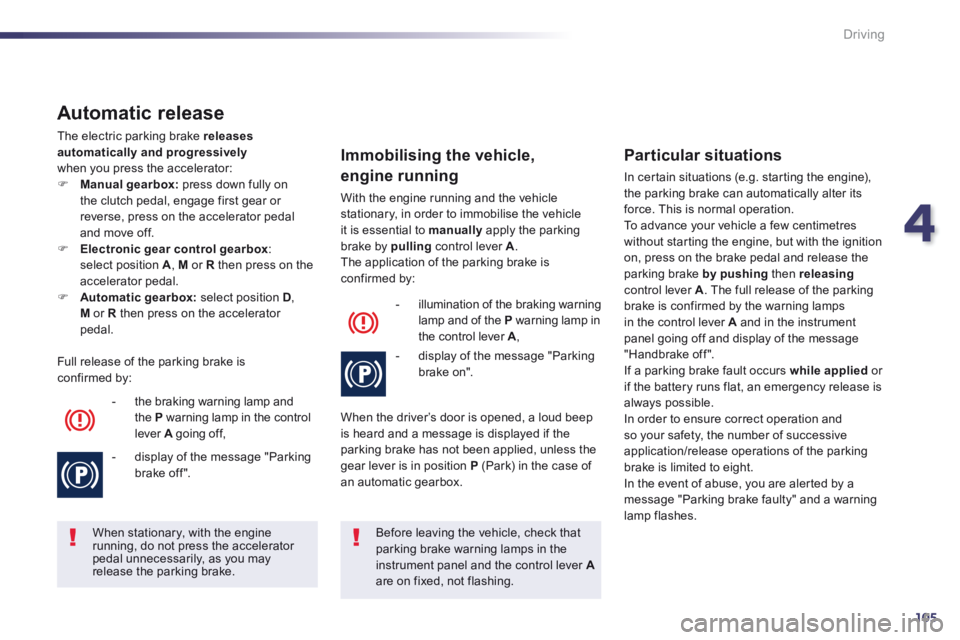
4
105
Driving
Automatic release
The electric parking brake releases automatically and progressivelywhen you press the accelerator: Manual gearbox: press down fully on the clutch pedal, engage first gear or reverse, press on the accelerator pedal and move off. Electronic gear control gearbox : select position A , M or R then press on the accelerator pedal. Automatic gearbox: select position D , M or R then press on the accelerator pedal.
Full release of the parking brake is confirmed by:
- the braking warning lamp and the P warning lamp in the control lever A going of f, A going of f, A
- display of the message "Parking brake off ".
When stationary, with the engine running, do not press the accelerator pedal unnecessarily, as you may release the parking brake.
Before leaving the vehicle, check that parking brake warning lamps in the instrument panel and the control lever Aare on fixed, not flashing.
Immobilising the vehicle,
engine running
With the engine running and the vehicle stationary, in order to immobilise the vehicle
it is essential to manually apply the parking brake by pulling control lever A . The application of the parking brake is confirmed by:
- illumination of the braking warning lamp and of the P warning lamp in the control lever A ,
- display of the message "Parking brake on".
When the driver’s door is opened, a loud beep is heard and a message is displayed if the parking brake has not been applied, unless the gear lever is in position P (Park) in the case of an automatic gearbox.
Particular situations
In certain situations (e.g. starting the engine), the parking brake can automatically alter its force. This is normal operation.
To advance your vehicle a few centimetres without starting the engine, but with the ignition on, press on the brake pedal and release the parking brake by pushing then releasingcontrol lever A . The full release of the parking brake is confirmed by the warning lamps in the control lever A and in the instrument panel going off and display of the message "Handbrake off ". If a parking brake fault occurs while applied or if the battery runs flat, an emergency release is always possible. In order to ensure correct operation and so your safety, the number of successive application/release operations of the parking brake is limited to eight. In the event of abuse, you are alerted by a message "Parking brake faulty" and a warning lamp flashes.
Page 108 of 352
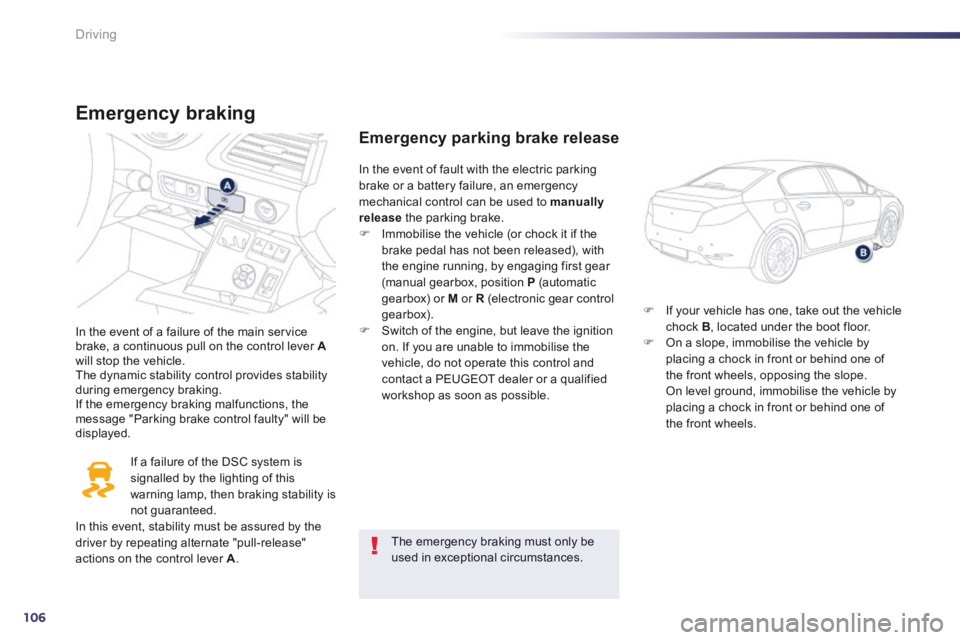
106
Driving
Emergency braking
In the event of a failure of the main service brake, a continuous pull on the control lever Awill stop the vehicle. The dynamic stability control provides stability during emergency braking. If the emergency braking malfunctions, the message "Parking brake control faulty" will be displayed.
If a failure of the DSC system is signalled by the lighting of this warning lamp, then braking stability is not guaranteed. In this event, stability must be assured by the
driver by repeating alternate "pull-release" actions on the control lever A .
Emergency parking brake release
If your vehicle has one, take out the vehicle chock B , located under the boot floor. On a slope, immobilise the vehicle by placing a chock in front or behind one of the front wheels, opposing the slope. On level ground, immobilise the vehicle by placing a chock in front or behind one of the front wheels.
In the event of fault with the electric parking brake or a battery failure, an emergency mechanical control can be used to manually release the parking brake.
Immobilise the vehicle (or chock it if the brake pedal has not been released), with the engine running, by engaging first gear (manual gearbox, position P (automatic gearbox) or M or R (electronic gear control gearbox). Switch of the engine, but leave the ignition on. If you are unable to immobilise the vehicle, do not operate this control and contact a PEUGEOT dealer or a qualified workshop as soon as possible.
The emergency braking must only be used in exceptional circumstances.
Page 112 of 352

110
Driving
Manual parking brake
Application
Pull the parking brake lever up to immobilise your vehicle.
Release
Pull the parking brake lever up gently, press the release button then lower the lever fully.
When parking on a slope, direct your wheels against the kerb, apply the parking brake, engage a gear with a manual gearbox or position P with an automatic gearbox and switch off the ignition. When the vehicle is being driven, if this warning lamp and the STOPwarning lamp come on, accompanied by an audible signal and a message in the instrument panel screen, indicating that the parking brake is still on or has not been fully released.
Page 113 of 352
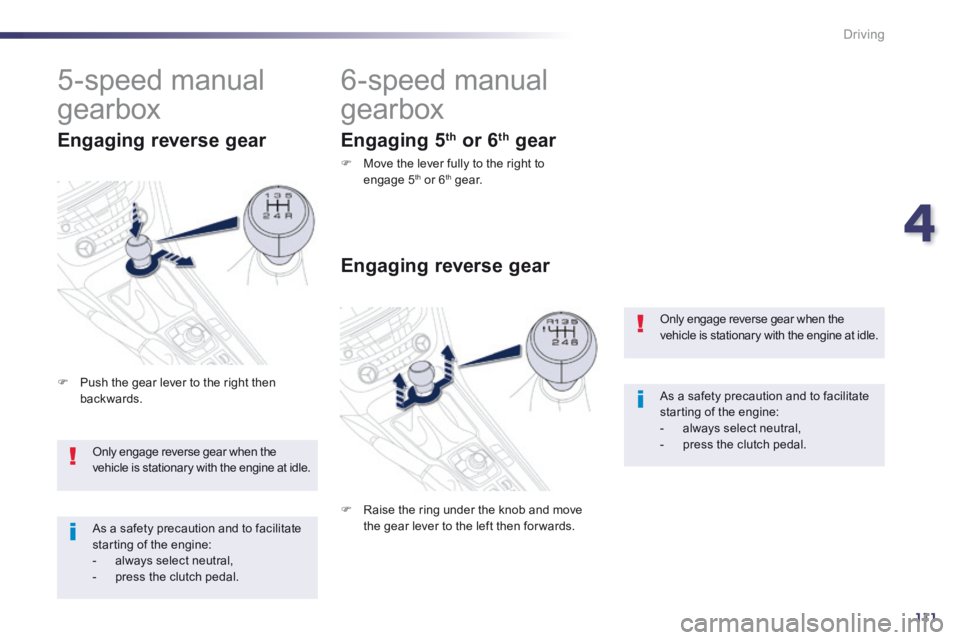
4
111
Driving
Only engage reverse gear when the vehicle is stationary with the engine at idle.
As a safety precaution and to facilitate starting of the engine: - always select neutral, - press the clutch pedal.
6-speed manual
gearbox
Engaging 5 th or 6 th gear
Move the lever fully to the right to engage 5 th or 6 th g e a r.
Only engage reverse gear when the vehicle is stationary with the engine at idle.
As a safety precaution and to facilitate starting of the engine: - always select neutral, - press the clutch pedal.
5-speed manual
gearbox
Push the gear lever to the right then backwards.
Engaging reverse gear
Engaging reverse gear
Raise the ring under the knob and move the gear lever to the left then for wards.
Page 114 of 352

112
Driving
Gear shift indicator * System which reduces fuel consumption by advising the driver to change up on vehicles fitted with a manual gearbox.
Operation
The system intervenes only when driving economically. Depending on the driving situation and your vehicle's equipment, the system may advise you to skip one or more gears. You can follow this instruction without engaging the intermediate gears. The gear engagement recommendations must not be considered compulsory. In fact, the configuration of the road, the amount of traffic and safety remain determining factors when choosing the best gear. Therefore, the driver remains responsible for deciding whether or not to follow the advice given by the system. This function cannot be deactivated.
* According to engine.
- You are in third gear.
Example:
- You press the accelerator pedal moderately.
- The system may suggest that you engage a higher gear, if appropriate.
The information appears in the instrument panel in the form of an arrow accompanied by the suggested gear.
In the case of driving which makes particular demands on the performance of the engine (firm pressure on the accelerator pedal, for example, when overtaking...), the system will not recommend a gear change. The system never suggests: - engaging first gear, - engaging reverse gear, - engaging a lower gear.
Page 115 of 352
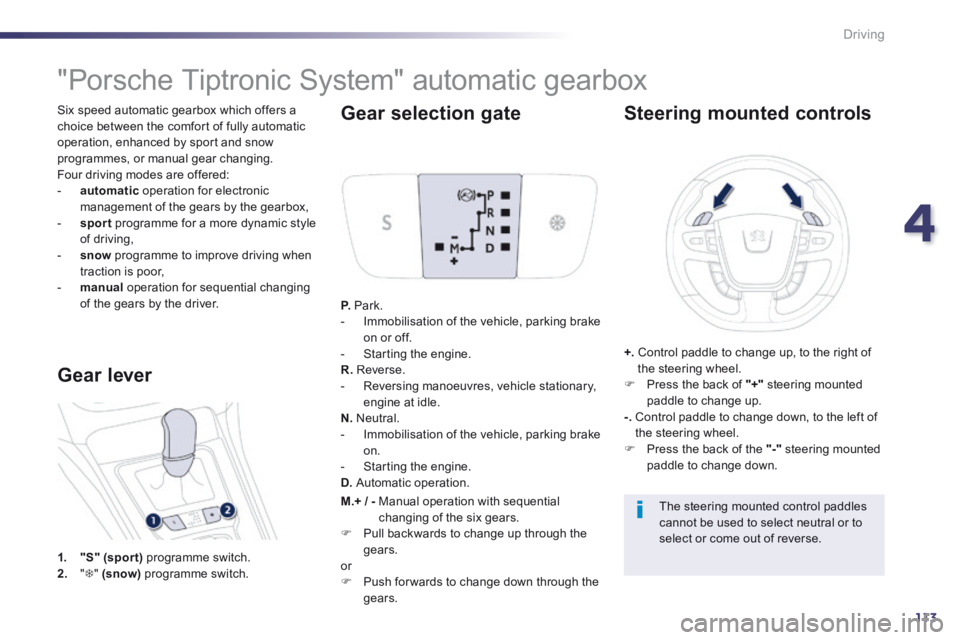
4
113
Driving
Six speed automatic gearbox which offers a choice between the comfort of fully automatic operation, enhanced by sport and snow programmes, or manual gear changing. Four driving modes are offered: - automatic operation for electronic management of the gears by the gearbox, - sport programme for a more dynamic style of driving, - snow programme to improve driving when traction is poor, - manual operation for sequential changing of the gears by the driver.
"Porsche Tiptronic System" automatic gearbox
1. "S" (spor t) programme switch. 2. " " (snow) programme switch.
Gear lever
Gear selection gate
P. Park. - Immobilisation of the vehicle, parking brake on or off. - Starting the engine. R. Reverse. - Reversing manoeuvres, vehicle stationary, engine at idle. N. Neutral. - Immobilisation of the vehicle, parking brake on. - Starting the engine. D. Automatic operation.
Steering mounted controls
+. Control paddle to change up, to the right of the steering wheel. Press the back of "+" steering mounted paddle to change up. -. Control paddle to change down, to the left of the steering wheel. Press the back of the "-" steering mounted paddle to change down.
The steering mounted control paddles cannot be used to select neutral or to select or come out of reverse.
M.+ / - Manual operation with sequential changing of the six gears. Pull backwards to change up through the gears. or Push for wards to change down through the
gears.
Page 117 of 352
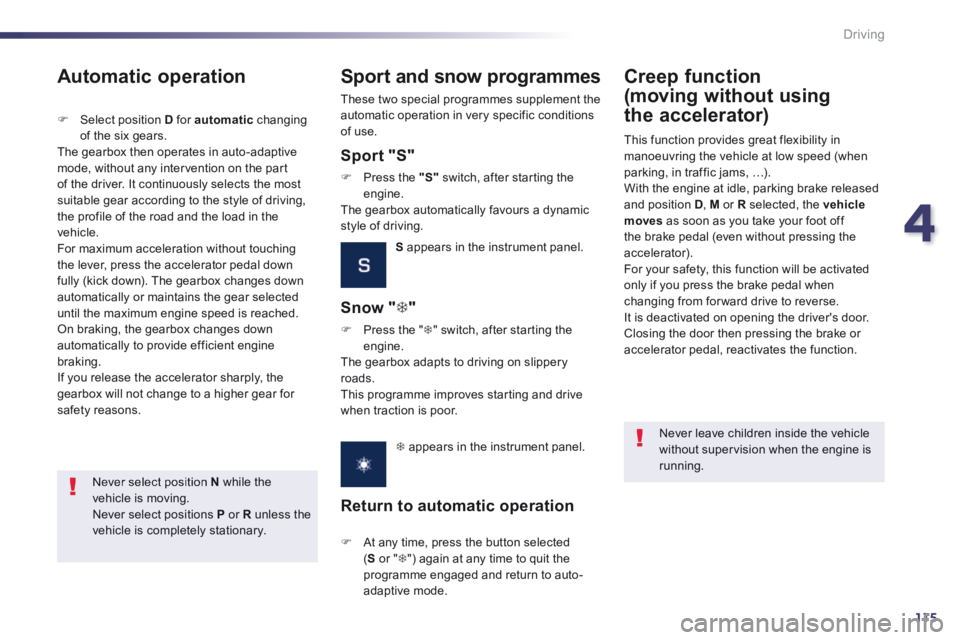
4
115
Driving
Never select position N while the vehicle is moving. Never select positions P or R unless the vehicle is completely stationary.
Automatic operation
Select position D for automatic changing of the six gears. The gearbox then operates in auto-adaptive mode, without any intervention on the part of the driver. It continuously selects the most suitable gear according to the style of driving, the profile of the road and the load in the vehicle. For maximum acceleration without touching the lever, press the accelerator pedal down fully (kick down). The gearbox changes down automatically or maintains the gear selected until the maximum engine speed is reached. On braking, the gearbox changes down automatically to provide efficient engine braking. If you release the accelerator sharply, the gearbox will not change to a higher gear for safety reasons.
Sport and snow programmes
Sport "S"
Press the "S" switch, after starting the engine. The gearbox automatically favours a dynamic style of driving.
S appears in the instrument panel.
Snow " "
Press the " " switch, after starting the engine. The gearbox adapts to driving on slippery roads. This programme improves starting and drive when traction is poor.
appears in the instrument panel.
Return to automatic operation
At any time, press the button selected (S or " ") again at any time to quit the programme engaged and return to auto-
adaptive mode.
These two special programmes supplement the automatic operation in very specific conditions of use.
Creep function
(moving without using
the accelerator)
This function provides great flexibility in manoeuvring the vehicle at low speed (when parking, in traffic jams, …). With the engine at idle, parking brake released and position D , M or R selected, the vehicle moves as soon as you take your foot off the brake pedal (even without pressing the accelerator). For your safety, this function will be activated only if you press the brake pedal when changing from for ward drive to reverse. It is deactivated on opening the driver's door. Closing the door then pressing the brake or accelerator pedal, reactivates the function.
Never leave children inside the vehicle without supervision when the engine is running.
Page 118 of 352
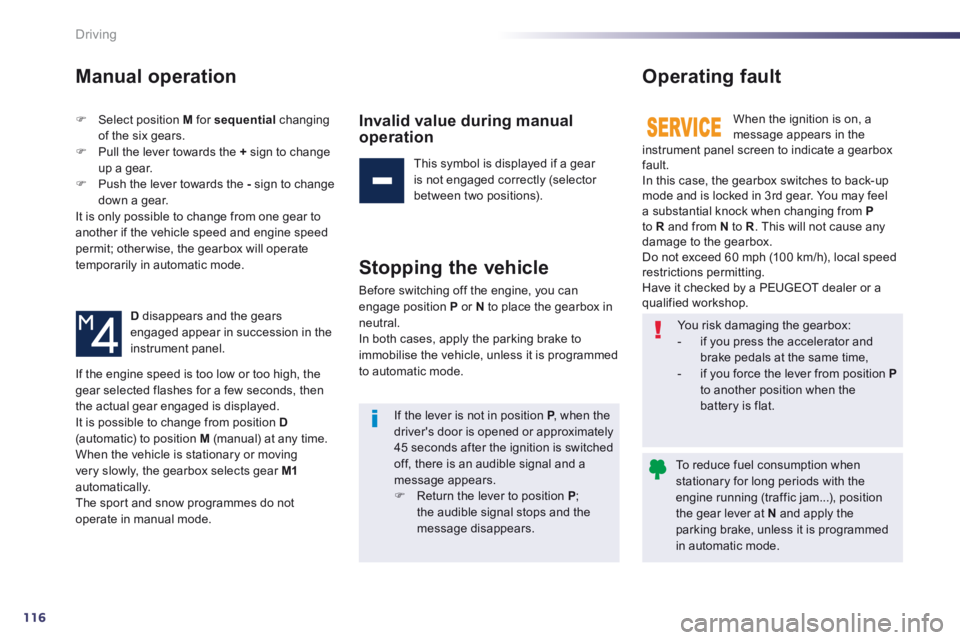
116
Driving
Manual operation
Select position M for sequential changing of the six gears. Pull the lever towards the + sign to change up a gear. Push the lever towards the - sign to change down a gear. It is only possible to change from one gear to another if the vehicle speed and engine speed permit; otherwise, the gearbox will operate temporarily in automatic mode.
D disappears and the gears engaged appear in succession in the instrument panel.
Invalid value during manual operation
This symbol is displayed if a gear is not engaged correctly (selector between two positions).
Stopping the vehicle
Before switching off the engine, you can engage position P or N to place the gearbox in neutral. In both cases, apply the parking brake to immobilise the vehicle, unless it is programmed to automatic mode.
Operating fault
When the ignition is on, a message appears in the instrument panel screen to indicate a gearbox fault. In this case, the gearbox switches to back-up mode and is locked in 3rd gear. You may feel a substantial knock when changing from Pto R and from N to R . This will not cause any damage to the gearbox. Do not exceed 60 mph (100 km/h), local speed restrictions permitting. Have it checked by a PEUGEOT dealer or a qualified workshop.
If the engine speed is too low or too high, the gear selected flashes for a few seconds, then the actual gear engaged is displayed. It is possible to change from position D
(automatic) to position M (manual) at any time. When the vehicle is stationary or moving very slowly, the gearbox selects gear M1automatically. The sport and snow programmes do not operate in manual mode.
You risk damaging the gearbox: - if you press the accelerator and brake pedals at the same time, - if you force the lever from position Pto another position when the battery is flat. If the lever is not in position P , when the P , when the Pdriver's door is opened or approximately 45 seconds after the ignition is switched off, there is an audible signal and a message appears. Return the lever to position P ; the audible signal stops and the message disappears.
To reduce fuel consumption when stationary for long periods with the engine running (traffic jam...), position the gear lever at N and apply the parking brake, unless it is programmed in automatic mode.